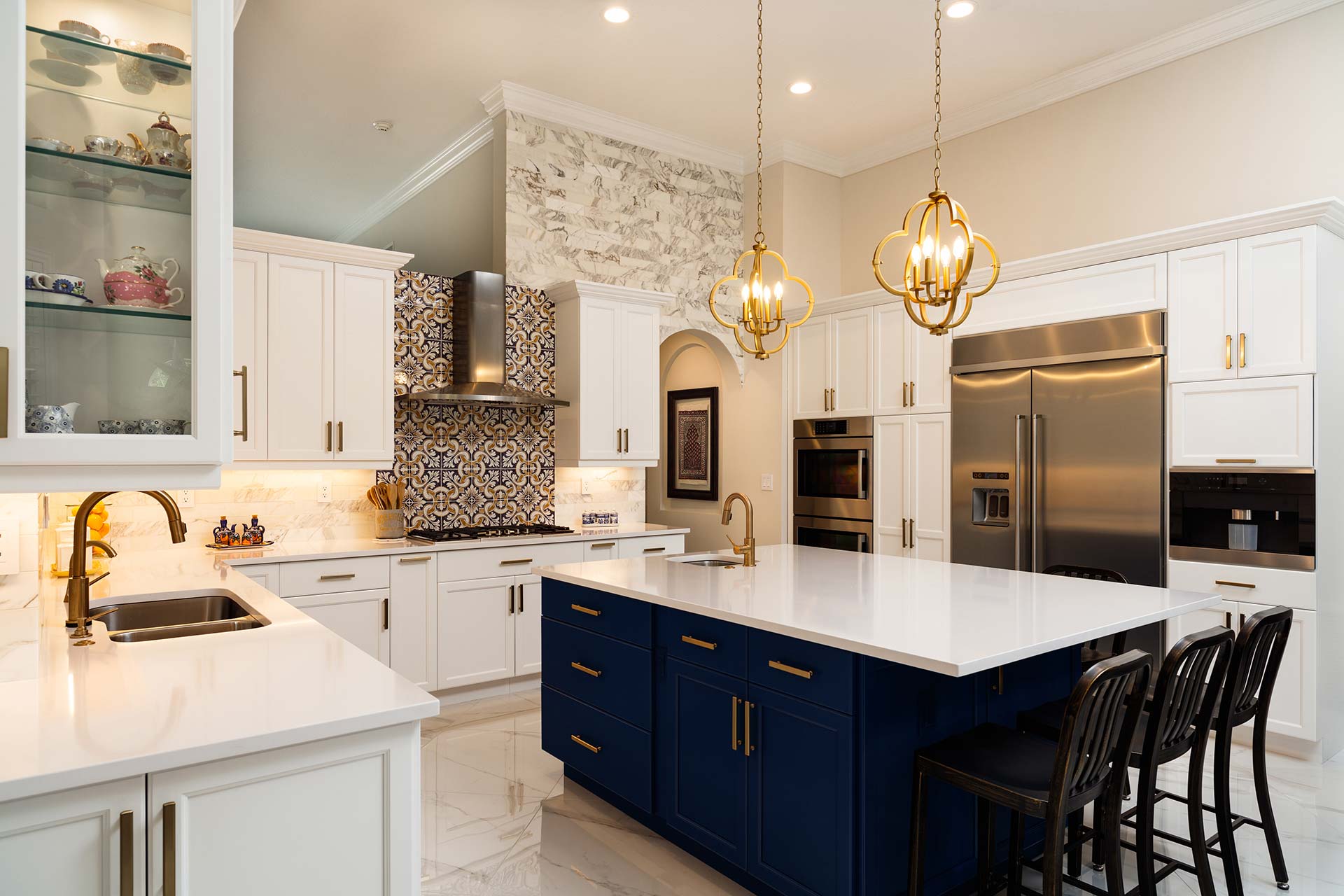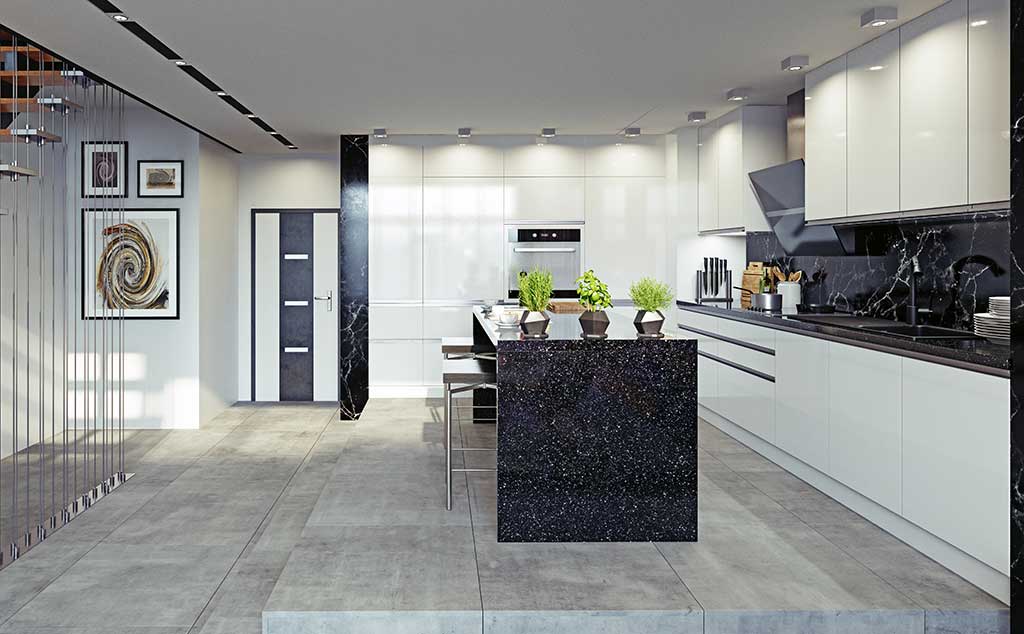
The kitchen seems to be a natural fit for tile flooring. Tiles are not only durable and resilient to heavy foot traffic and stains, but the tiles can be a critical part of the overall kitchen design. Kitchen floor tile ideas abound, so just one look at the many ways to use tile in your kitchen can have you feeling overwhelmed. Here’s a breakdown of key considerations when choosing the best tile for kitchen floor coverage and how to select the perfect kitchen floor tiles for your space.

Important Tips on How to Choose Kitchen Floor Tiles
From porcelain kitchen floor tiles to ceramic and stone, you have a wealth of options to consider. The costs of a tile floor can range from $2 to $100 per square foot, and numerous textures and styles are available. Here is a closer look at tips for choosing the best tile for kitchen floor.
- Durability: Tiles can have different ratings depending on their levels of durability. For kitchens, Class 3 and Class 4 tiles tend to offer the most resilience. Either of these ratings means the tile can stand up to high levels of foot traffic. Opt for tiles that can withstand the rigors of daily life, including spills, dropped utensils, and heavy foot traffic. Porcelain and ceramic tiles are excellent choices, known for their toughness.
- Style and Aesthetics: Your kitchen floor should complement your overall design scheme. Consider the color, pattern, and texture of the tiles. Whether you prefer a classic, modern, or rustic look, there’s a tile to match your vision.
- Ease of Maintenance: Kitchen floors are prone to spills and stains. Choose tiles that are easy to clean and maintain. Porcelain and natural stone tiles, when properly sealed, are resistant to staining.
- Be Mindful of Water Resistance: Some tiles are more porous than others. You definitely don’t want a tile in your kitchen that absorbs and holds water, as this can also mean the tile hangs onto bacteria. Some natural stones can be more porous, so be sure to weigh your options carefully. Porcelain, ceramic, and vinyl tiles are good options in this regard.
- Comfort: If you spend a lot of time standing in the kitchen, consider the comfort factor. Softer materials like vinyl provide a more forgiving surface underfoot.
- Budget: Set a budget for your kitchen flooring project. Tiles come in a wide range of price points, so knowing your budget will help you narrow down your options. If you’re looking for a budget-friendly choice, consider ceramic or vinyl tiles, which are often among the least expensive options without sacrificing durability or style. On the other hand, if you have a more generous budget and desire luxurious options, natural stone tiles like marble or exotic hardwood-look porcelain tiles may be the way to go.
- Size and Layout: Think about the size and layout of the tiles. Larger tiles can make a space appear more expansive, while smaller tiles can create intricate patterns. The layout, such as herringbone or diagonal patterns, can add visual interest.
- Grout Color: Don’t forget to consider the grout color. It can significantly impact the overall look of your floor. Choose a grout color that complements your tile choice.
- Textured or Smooth: Textured tiles are nice underfoot because they help thwart the risks of falling if the floor gets wet. While a nice clean and shiny surface may be attractive, additional glazing on something like porcelain can prove to be problematic in your kitchen.
- Samples and Visuals: Always request samples or view visual representations of the tiles you’re considering. Seeing them in your kitchen’s lighting and alongside your cabinets and countertops can help you make an informed decision.
- Professional Installation: Finally, for a successful kitchen flooring project, it’s essential to invest in professional installation. A well-executed installation by an experienced home remodeling contractor ensures that your chosen tiles remain sturdy and attractive for years to come.
Consider Material Options
When it comes to kitchen floor tile ideas, you’re presented with three primary choices: stone, ceramic, and porcelain tiles. Each option—stone, ceramic, and porcelain—brings its own unique set of qualities to the table. Stone tiles, such as marble, travertine, granite, or slate, embody timeless elegance and natural beauty, making them a popular choice for those seeking a touch of luxury. Ceramic tiles, on the other hand, offer versatility and a wide range of colors and patterns, allowing you to match your kitchen’s style effortlessly. Porcelain tiles, known for their exceptional durability and water resistance, are ideal for high-traffic kitchens and spill-prone areas.
Stone Tiles for Your Kitchen Flooring: Timeless Elegance

Stone tiles, crafted from genuine natural stone such as travertine and granite, boast several notable advantages. Firstly, the organic nature of stone provides a unique texture and excellent traction, ensuring safety in your kitchen. Although the initial cost of natural stone can be higher, it’s an investment in exceptional durability that can stand the test of time. The primary consideration, apart from the cost, is the need for periodic sealing to safeguard the materials, which is a crucial step in maintaining their longevity.
Ceramic Tiles: Versatile and Stylish Flooring Solutions

Ceramic tiles are a staple in numerous kitchens, thanks to their versatility and widespread appeal. Crafted from various clay types, ceramic tiles showcase remarkable resistance to stains and can be effortlessly customized to fit your installation needs. The budget-friendly nature of ceramic, coupled with an abundant array of colors and styles, positions it as a favored choice among homeowners. However, it’s worth noting that ceramic may not match the resilience of porcelain or natural stone. Its softer composition renders it susceptible to breakage upon direct impact.
Porcelain Tiles: A Blend of Durability and Elegance

Porcelain tiles are made from clay and sand, heat and pressure-treated, and less porous compared to ceramic. For these reasons, porcelain is often thought to be the best tile for kitchen floor coverings. While the finish can be polished and glossy, some porcelain tiles also have a rough texture treatment. Porcelain tile can take longer to install, which means installation can be a bit more costly.
Choosing Your Ideal Kitchen Floor Tile: A Personalized Path to Style and Functionality
In the world of kitchen floor tiles, each option—stone, ceramic, and porcelain—brings its own unique set of qualities to enhance your space. While stone tiles excel in aesthetics, ceramic and porcelain shine in terms of functionality and affordability. Ultimately, the choice between these three options hinges on your priorities—whether it’s the captivating allure of natural stone, the design flexibility of ceramic, or the resilience of porcelain. Whichever path you choose, your kitchen floor will not only be a functional foundation but also a statement of your style and practicality.